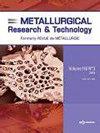Achieving stable steelmaking basic oxygen furnace slag through treatment by self-disintegration high pressure process
IF 1.1
4区 材料科学
Q3 METALLURGY & METALLURGICAL ENGINEERING
引用次数: 1
Abstract
The basic oxygen furnace slag generated during steelmaking can be reused as aggregates in civil engineering because of its chemical composition and technological properties. However, the utilization of steel slag in practical applications is quite low due to its low volume stability. In this work, highly stable slag is obtained by the environmental-friendly self-disintegration high pressure (SDHP) process. In this method, the molten slag is initially crushed to form numerous small bulks. Subsequently, the slag bulks are treated by the self-disintegration process at a high pressure to obtain the highly stable steel slag. Thermodynamic evaluation and experimental investigation reveal that high pressure of steam promotes the hydration reaction. At a pressure of 0.2 MPa, the free lime (f-CaO) content and immersion expansion rate of the steel slag treated by this method are reduced to 1.5% and 0.9%, respectively. Both of these values satisfy the requirements specified in the national standards (GB/T 25029-2010 and GB/T 20491-2006). Moreover, the treatment time is reduced to 1.5 h, which is far lower than the treatment times required for traditional methods.采用高压自崩解法处理炼钢碱性氧炉渣,达到稳定炼钢碱性氧炉渣的目的
炼钢过程中产生的碱性氧炉渣具有良好的化学成分和工艺性能,可作为集料在土木工程中重复利用。但由于钢渣的体积稳定性不高,在实际应用中的利用率很低。采用环境友好型高压自崩解(SDHP)工艺获得了高稳定性的矿渣。在这种方法中,熔渣最初被粉碎成许多小块。然后对渣块进行高压自崩解处理,得到高稳定的钢渣。热力学评价和实验研究表明,高压蒸汽促进了水化反应。在0.2 MPa压力下,经该方法处理的钢渣的游离石灰(f-CaO)含量和浸胀率分别降至1.5%和0.9%。这两个值均满足国家标准GB/T 25029-2010和GB/T 20491-2006的要求。处理时间缩短至1.5 h,远低于传统方法所需的处理时间。
本文章由计算机程序翻译,如有差异,请以英文原文为准。
求助全文
约1分钟内获得全文
求助全文
来源期刊

Metallurgical Research & Technology
METALLURGY & METALLURGICAL ENGINEERING-
CiteScore
1.70
自引率
9.10%
发文量
65
审稿时长
4.4 months
期刊介绍:
Metallurgical Research and Technology (MRT) is a peer-reviewed bi-monthly journal publishing original high-quality research papers in areas ranging from process metallurgy to metal product properties and applications of ferrous and non-ferrous metals and alloys, including light-metals. It covers also the materials involved in the metal processing as ores, refractories and slags.
The journal is listed in the citation index Web of Science and has an Impact Factor.
It is highly concerned by the technological innovation as a support of the metallurgical industry at a time when it has to tackle severe challenges like energy, raw materials, sustainability, environment... Strengthening and enhancing the dialogue between science and industry is at the heart of the scope of MRT. This is why it welcomes manuscripts focusing on industrial practice, as well as basic metallurgical knowledge or review articles.
 求助内容:
求助内容: 应助结果提醒方式:
应助结果提醒方式:


